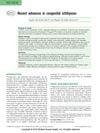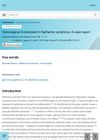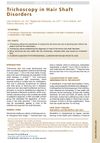TLDR LEKTI is crucial for skin barrier and immune function, affecting conditions like Netherton syndrome and atopic dermatitis.
Netherton syndrome, a rare autosomal recessive disorder, was characterized by ichthyosis, bamboo hair, and severe atopic manifestations due to mutations in the SPINK5 gene, which encodes the serine protease inhibitor LEKTI. This study highlighted the critical role of LEKTI in maintaining epidermal barrier function and regulating immune responses. Mutations in SPINK5 were linked to atopic dermatitis, with increased protease activity leading to skin barrier defects and heightened allergen absorption. Genome-wide association studies identified various genetic loci associated with atopic dermatitis, emphasizing its complex genetic nature. The research underscored the importance of protease inhibitors like LEKTI in controlling protease activity, with implications for understanding and treating skin disorders like Netherton syndrome and atopic dermatitis.
717 citations
,
June 2010 in “Nature” Alopecia areata involves both innate and adaptive immunity, with specific genes linked to the disease.
372 citations
,
December 2004 in “Nature Genetics” 72 citations
,
July 1984 in “Journal of Investigative Dermatology” 264 citations
,
October 1958 in “Archives of Dermatology” A 4-year-old girl has a rare hair condition causing fragile, short hair.
72 citations
,
March 2023 in “Biomolecules” Dupilumab effectively treats various inflammatory skin diseases beyond its initial use for atopic dermatitis.
 10 citations
,
July 2015 in “Current opinion in pediatrics, with evaluated MEDLINE/Current opinion in pediatrics”
10 citations
,
July 2015 in “Current opinion in pediatrics, with evaluated MEDLINE/Current opinion in pediatrics” New genes linked to ichthyosis were found, but there's still no cure; treatment options are improving.
November 2019 in “Harper's Textbook of Pediatric Dermatology” Netherton syndrome is a genetic skin disorder causing severe skin issues and requires careful treatment to protect the skin barrier.
 January 2024 in “JAAD case reports”
January 2024 in “JAAD case reports” Netherton syndrome can cause severe and chronic vulvovaginal symptoms that may improve with continuous oral contraceptives.
 36 citations
,
August 2018 in “Dermatologic Clinics”
36 citations
,
August 2018 in “Dermatologic Clinics” Trichoscopy is a useful tool for diagnosing hair disorders without pulling out hair.


